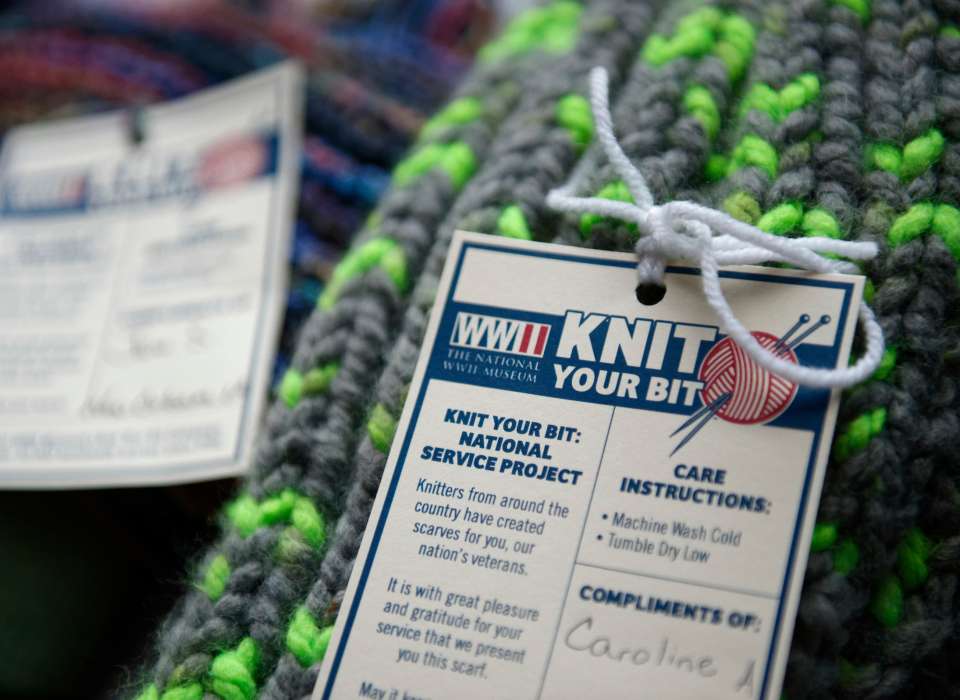With the onset of COVID-19, the American public is facing an invisible enemy that is changing whole aspects of our lives. From going to work and school, to getting supplies, the challenge of the pandemic brings a time of uncertainty and anxiety for many of us. For our healthcare system in the United States, the pressure to maintain and collect supplies has never been so important—even turning to the public for assistance with a number of things, including the storage of protective masks for those on the front lines. As we all shelter in place, it’s no better time for crafters, makers, and those who want to help to mobilize—just like we always have, especially during World War II.
On the Home Front during World War II, knitting served as one more way Americans could support the war effort. The November 24, 1941, cover story of the popular weekly magazine Life explained “How to Knit.” Along with basic instructions and a pattern for a simple knitted vest, the article advised, “To the great American question ‘What can I do to help the war effort?’ the commonest answer yet found is ‘Knit.’” After the Japanese attack on Pearl Harbor, two weeks later, thousands of Americans picked up their needles to knit socks, mufflers, and sweaters to keep American soldiers warm and provide them with a homemade reminder of home.
Many of those knitting items for soldiers during World War II had knit for victory as children or young adults during World War I. Knitting provided warmth and comfort for the servicemember, therapeutic distraction, and a sense of civic participation for the knitters. First Lady Eleanor Roosevelt was often photographed knitting for the war effort or at least carrying her voluminous knitting bag. In the evening listening to war news on the radio, idle hands were turned to service as Americans once again knit for victory.
The American Red Cross supplied patterns for sweaters, socks, mufflers, fingerless mitts (which allowed soldiers to keep their hands warm while shooting), toe covers (for use with a cast), stump covers, and other garments. Cold, wet, sore feet were the enemy as surely as German or Japanese troops. Socks wore out much faster than sweaters and needed changing many times more frequently. These were to be knitted in olive drab or navy blue wool yarn. Surviving patterns show that these knitting patterns were typed and retyped with carbon-paper copies and shared among the knitters. Many knitters chose to knit the same item in the same size again and again so that they could memorize the pattern and produce pieces more quickly.
“The Navy needs men, but it also needs knitters,” newspapers cried. Church basements, school lunchrooms, and members-only societies all had knitters busily clicking their needles. Their handiwork was destined to warm and protect, and fated to suffer with the soldiers. After the war, some knitters dropped their needles for good. Others kept on knitting throughout their lives in a wide variety of colors—any color, many swore but Army-issued khaki or olive drab!
Today, as calls for homemade surgical masks grow, it’s yet another time for Americans to rise to the occasion and all do our part to support our healthcare heroes and each other. To find out what hospitals and other healthcare workers need in your area and how to donate, check out the websites of your community’s hospitals. Additionally, companies like JOANN Fabrics and Crafts are spearheading this call to action to support our country's medical personnel with templates and donation locations. And, if you aren’t crafty, you can also help by practicing social distancing, checking on the elderly and immune-compromised safely, and staying home. If you have the space and the time, this is a great opportunity to learn what you can do to help your community and our country as a whole.
Remember, we can do it—together!
For more information on the Museum’s Knit Your Bit program, visit https://www.nationalww2museum.org/programs/knit-your-bit/.
Resources:
Healthcare-approved template for masks: https://www.craftpassion.com/wp-json/mv-create/v1/creations/19/print
Template for hospital gowns: https://www.lazygirldesigns.com/free-hospital-gown-patterns/?fbclid=IwAR2fiFrOWQRwCsVziEEpeTa141h1KQr9e2Qf0GQ5331OlnVI8qYDuyqqc2I
JOANN Fabrics and Crafts list of how-tos, materials, and donation information: https://www.joann.com/make-to-give-response/
